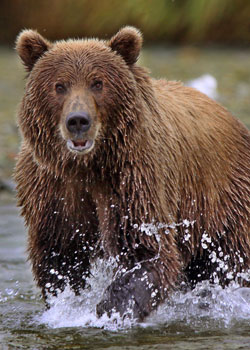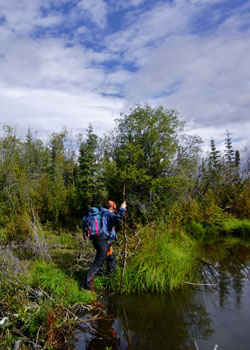The challenge
Running from northern British Columbia into southern Yukon, the Northern Boreal Mountains area is a magnificent rugged and remote region with remarkably diverse ecosystems, including pristine lakes, grasslands, and boreal and subalpine forests. Valley bottoms provide the richest and most productive habitats, and include lakes, wetlands, and forests of lodgepole pine and white spruce. These valleys also have ecologically valuable pockets of old-growth forest especially along gravel-bed river floodplains.
The region boasts some of the last remaining intact wildlife communities in North America. Here, forest and mountain predators like gray wolf, wolverine, Canada lynx, and grizzly bear have room to roam, while their prey populations abound, including mountain caribou, thinhorn sheep, moose, elk, wood bison, mountain goat, beavers, and snowshoe hare.
Northern Boreal Mountain lakes, meanwhile, provide critical refuelling stops for waterfowl and shorebirds migrating to and from nesting grounds in the Arctic, and songbirds that winter as far away as South America breed in the region’s lowland forests and wetlands. The Yukon, Taku, Stikine, and Alsek Rivers support Pacific salmon runs that sustain river otters, bald eagles, and humans, including some of the 14 First Nations whose Traditional Territories lie in this approximately 419,000 km2 region.
Today, there are many growing pressures on the region, including mining, oil-and-gas development, agriculture, forestry, and roads. These new land uses could fundamentally alter one of our greatest wild regions unless we quickly develop plans for keeping the wild intact from mountain peak to valley bottom.



.jpg?ver=2019-02-26-183843-610)
What we are doing and why
There is growing interest in developing the mineral riches of the Yukon, gas reserves in northern BC, and to develop pipelines and transport corridors across the region. There is also increasing interest in developing local sources of energy through wood biomass, and in expanding opportunities for local food production. In light of these growing and new land uses, WCS Canada working to engage governments and First Nations in proactive planning to protect key areas and critical habitats to ensure wildlife populations remain healthy, particularly in the face of a changing climate.
The interconnected nature of this region and its diversity of habitats and geography – from mountain slopes to valley forests – means that it may offer wildlife valuable pathways for adaptation to climate change. But we are already seeing evidence of the growing impacts of a changing climate, including increasingly intense wild fires, so it is vital that we factor climate resilience into land-use plans.
Because the forests, lakes, rivers, and wetlands of this region are generally healthy, intact and connected, we see the potential to develop modern conservation-first land-use plans that can ensure the survival of species and community prosperity. But we must act before myriad different developments begin to carve up the region into much less ecologically valuable fragments.
Our strategies
In southern Yukon, we have tracked otters over ice and land to map critical pathways for protection across the landscape, while along the Tintina Trench migratory flyway, we are tracking birds to identify critical sites and habitats in need of protection.
Across the Boreal Mountains of the Yukon, we used novel computer modelling tools developed by the BEACONs project to identify large, intact areas that can accommodate natural disturbance regimes, key wildlife habitats, ecosystem representation, and watershed connectivity, providing the “ecological benchmarks” to frame land protection.
In the mountainous Muskwa-Kechika area of northern BC, we are doing field research to help identify key habitats and wildlife populations to enhance previous conservation-based land-use planning in order to better protect the region’s wild character in the face of increased oil-and-gas development.
Latest news
- Dr. Don Reid publishes new report "Conservation of Lakeshore Zones in the Northern Boreal Mountains: State of Knowledge, and Principles and Guidelines for Planning and Management".
- Research from the University of Alberta and WCS Canada finds pockets of Canada's boreal forest that act as "refugia" against climate change (Canadian Geographic).
- WCS Canada scientists explain why burning wood for energy is not a climate-friendly policy in Yukon News.
- Dr. Don Reid provided a commentary in the Yukon News on why Yukon's wild places are not exempt from habitat alteration and species loss.
- WCS Canada scientist Dr. John Weaver has developed a bold plan to build on the existing array of protected areas scattered across the Greater Muskwa-Kechika. His report was featured in an article in the Narwhal.
- WCS Canada scientist Dr. Don Reid helped to author an assessment of conservation values in Yukon’s pristine Peel Watershed. A 2017 Supreme Court decision helped restore progress on a plan to protect much of the watershed and the final plan was signed off by Yukon First Nations and the Yukon Government in August 2019. This is a massive milestone for conservation in Yukon with 83% of the region set aside in some form of formal protection. More details about this special area and plan can be found at protectpeel.ca
- In an opinion piece for the Narwhal, our President, Dr. Justina Ray, talks about how delay and inaction have led to a crisis situation for caribou in southern British Columbia -- a crisis that it is going to take many hands to solve
- Dr. Hilary Cooke documents her experiences tracking birds in the Tintina Trench, part of a major western flyway, in two blog posts: Birds, birds, and more birds: A migration moment like no other, A northern spring: hope for the birds, and for me
- Using computer modelling, WCS Canada has mapped priority areas for conservation in Southern Yukon: Securing a wild future: Planning for landscape-scale conservation in Yukon’s Boreal Mountains.
- In a July 2018 keynote address to the North American Congress for Conservation Biology, WCS Canada President Dr. Justina Ray discussed the need for new approaches to conservation and land-use planning (view video here).